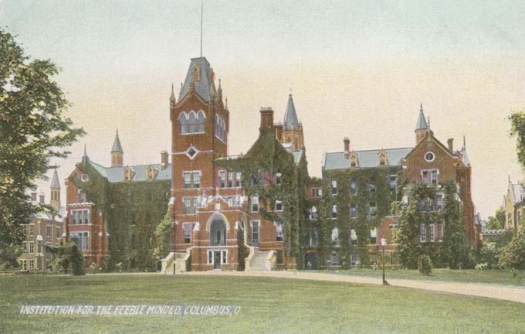
(Courtesy Columbus Metro Library Historic Photograph Collection; used with permission)
Copyright © 2005-2017
Ohio American Local Hisotry Network
No copyright is claimed on non-original or licensed material.
Return to Early Institutions
Go to Main Page

(Courtesy Columbus Metro Library Historic Photograph Collection; used with permission)
|
THIS Institution was established by law April 17, 1857. The preliminary work was commenced in 1849 by Dr. N. S. Townshend, while pursuing his medical studied in Paris, became interested in the labors of Seguin, Itard and others in behalf of the class. In 1853 Dr. Townshend, then a member of the Ohio Senate, so interested Governor Medill in the results of his observations and studies abroad, that he devoted a portion of his message to the General Assembly to the subject. That part of the message relating to the subject was referred to a select committee, of which Dr. Townshend was chairman. This committee made a report, detailing what had been done for this class. A bill was then introduced for the establishment of an Institution, but did not pass. At the session of 1857, Hon. Herrman Canfield introduced in the Senate a bill to establish an Asylum for Idiots, which passed both Houses and became a law April 17, 1857. Governor Chase appointed William Dennison, Norton S. Townshend and Asher Cook, Trustees. Upon organization of the Board, Mr. Dennison was made chairman; Dr. Townshend, secretary, and Dr. R. J. Patterson, superintendent. The Board rented the buildings on East Main street, now occupied as the "Home for the Friendless." The Institution was opened with nine pupils. The number was increased to fifteen at the date of the first report. The rented premises were occupied until 1868, the number of pupils averaging, after the first two years, between forty and fifty. The office of assistant superintendent was created in 1859, and Dr. G. A. Doren was appointed to that position. In 1860, the superintendent, Dr. Patterson, resigned, and Dr. Doren was elected superintendent by the Board of Trustees, and has continued in that position since, now forty-one years. After closely observing the operations of the Institution and their results, the Legislature, in 1864, provided for the permanent establishment of the Institution, authorizing buildings upon a suitable site for the accommodation of two hundred pupils. This provision was made during the strenuous days of the Civil War, and was a strong endorsement of the value of the Institution, as well as a valued acknowledgment of the performance of duty under the trying conditions of the War. The new buildings were occupied in August, 1868, the number of inmates soon reaching three hundred. The practical value of the Institution being demonstrated, additions were made, from year to year, until the 18th of November, 1881, when over six hundred children were accommodated, and when the main buildings were destroyed by fire; happily, without loss of life, or even injury, to any of the inmates, officers or employes. So anxious were parents and guardians that their children and wards should not lose any of the benefits of the Institution, that only one hundred of the inmates could be sent to their homes, the balance being crowded into the buildings that escaped destruction. The operations of the Institution were conducted, during the three years of rebuilding, at great disadvantage, from want of room and facilities for the proper care and training of the inmates. This was relieved by the occupation of the new buildings in 1884. In this case, fireproof buildings were constructed on the site of those destroyed by fire, and fireproof outside stairways provided for all buildings that escaped destruction. Other buildings have been added since 1884, until the number accommodated in 1900 was 1100, when, the Legislature, recognizing the duty of providing against the increase of this unfortunate class, by placing them under such restrictions as will prevent them multiplying their kind, provided for a permanent home, where the use of such industrial power as they possess may be exercised in their own support. Authority was given to purchase a farm, not to exceed 1500 nor less that 1000 acres in extent, where they are to be kept through life, thus lessening the increase from that source. About 1200 acres have been secured, where the males of this class will be provided with a home and such employment as will come within the range of their capacities. The employments will be mainly such as furnished by the farm, gardening, stock-raising and horticultural pursuits. The females are to be provided for at the home, Institution where they can be better protected, as well as usefully employed in domestic occupations. Buildings are now being constructed to accommodate about four hundred of each sex of the Custodial Class and, when completed, will restore the old department to its original purpose and duties—"to furnish special means of improvement to that portion of our youth who are so deficient in mind, or have such marked peculiarities and eccentricities of intellect as to deprive them of the benefits of other educational institutions and ordinary methods of instruction."
|
Return to Early Institutions
Go to Main Page